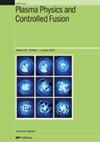2023 年 DIII-D 负三角活动成果概览
IF 2.3
2区 物理与天体物理
Q2 PHYSICS, FLUIDS & PLASMAS
引用次数: 0
摘要
负三角形(NT)是托卡马克核聚变能源的一种潜在变革性配置,它具有高性能堆芯、无边缘局部模式(ELM)边缘和低场边分流器,可以很容易地扩展到集成反应堆解决方案。先前在 TCV 和 DIII-D 托卡马克上进行的 NT 工作促使在 DIII-D 的低场侧下部外壁上安装石墨瓦铠装。为了验证未来反应堆的NT方案,专门进行了为期多周的实验活动。在 DIII-D NT 活动期间,在稳定控制的平均三角形 = -0.5 的强 NT 形放电中,同时实现了高约束(1)、高电流(3)和高归一化压力等离子体(2.5)。实验覆盖了 DIII-D 的广泛操作空间(等离子体电流、环形场、电子密度和压力),只要保持足够强的 NT,就不会在单次放电中触发 ELM;这与其他操作窗口较窄的高性能 ELM 抑制方案形成了鲜明对比。这些强NT等离子体具有较低的外部分流器X点形状,并保持着非ELM边缘和电子温度基座,超过了典型的L模式等离子体。此外,在这项活动中还取得了以下成果:高归一化密度(/至少为1.7),粒子约束与能量约束、无杂质播种的分离式分流器和使用外在杂质的地幔辐射方案相当。这些结果对于建立一个近地核聚变试验装置是很有希望的,但在约束外推法和核边缘整合方面仍存在进一步的问题,这促使未来在DIII-D及更远的地方开展近地核聚变研究。本文章由计算机程序翻译,如有差异,请以英文原文为准。
Overview of results from the 2023 DIII-D negative triangularity campaign
Negative triangularity (NT) is a potentially transformative configuration for tokamak-based fusion energy with its high-performance core, edge localized mode (ELM)-free edge, and low-field-side divertors that could readily scale to an integrated reactor solution. Previous NT work on the TCV and DIII-D tokamaks motivated the installation of graphite-tile armor on the low-field-side lower outer wall of DIII-D. A dedicated multiple-week experimental campaign was conducted to qualify the NT scenario for future reactors. During the DIII-D NT campaign, high confinement ( 1), high current ( 3), and high normalized pressure plasmas ( 2.5) were simultaneously attained in strongly NT-shaped discharges with average triangularity = −0.5 that were stably controlled. Experiments covered a wide range of DIII-D operational space (plasma current, toroidal field, electron density and pressure) and did not trigger an ELM in a single discharge as long as sufficiently strong NT was maintained; in contrast, to other high-performance ELM-suppression scenarios that have narrower operating windows. These strong NT plasmas had a lower outer divertor X-point shape and maintained a non-ELMing edge with an electron temperature pedestal, exceeding that of typical L-mode plasmas. Also, the following was achieved during the campaign: high normalized density ( / of at least 1.7), particle confinement comparable to energy confinement with , a detached divertor without impurity seeding, and a mantle radiation scenario using extrinsic impurities. These results are promising for a NT fusion pilot plant but further questions on confinement extrapolation and core-edge integration remain, which motivate future NT studies on DIII-D and beyond.
求助全文
通过发布文献求助,成功后即可免费获取论文全文。
去求助
来源期刊

Plasma Physics and Controlled Fusion
物理-物理:核物理
CiteScore
4.50
自引率
13.60%
发文量
224
审稿时长
4.5 months
期刊介绍:
Plasma Physics and Controlled Fusion covers all aspects of the physics of hot, highly ionised plasmas. This includes results of current experimental and theoretical research on all aspects of the physics of high-temperature plasmas and of controlled nuclear fusion, including the basic phenomena in highly-ionised gases in the laboratory, in the ionosphere and in space, in magnetic-confinement and inertial-confinement fusion as well as related diagnostic methods.
Papers with a technological emphasis, for example in such topics as plasma control, fusion technology and diagnostics, are welcomed when the plasma physics is an integral part of the paper or when the technology is unique to plasma applications or new to the field of plasma physics. Papers on dusty plasma physics are welcome when there is a clear relevance to fusion.
 求助内容:
求助内容: 应助结果提醒方式:
应助结果提醒方式:


